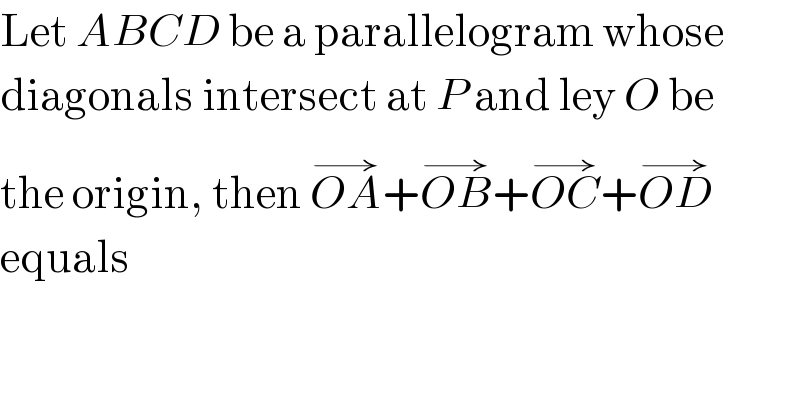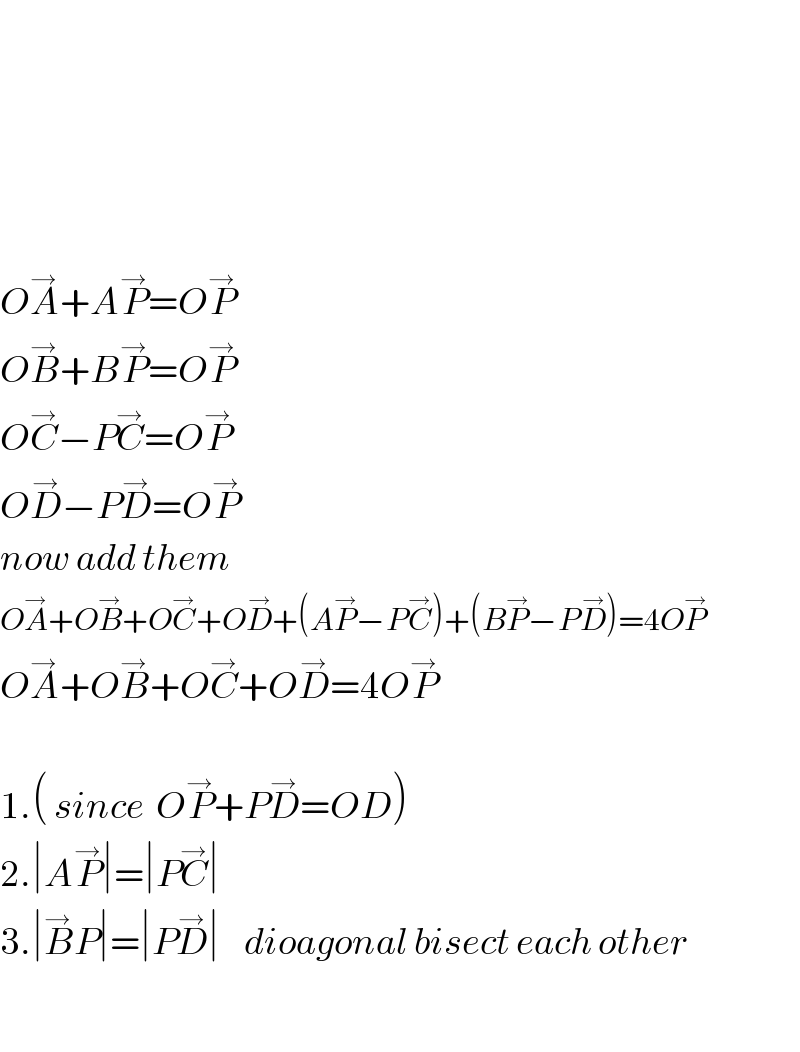Question Number 41291 by Mayur last updated on 04/Aug/18

$$\mathrm{Let}\:{ABCD}\:\mathrm{be}\:\mathrm{a}\:\mathrm{parallelogram}\:\mathrm{whose} \\ $$$$\mathrm{diagonals}\:\mathrm{intersect}\:\mathrm{at}\:{P}\:\mathrm{and}\:\mathrm{ley}\:{O}\:\mathrm{be} \\ $$$$\mathrm{the}\:\mathrm{origin},\:\mathrm{then}\:\overset{\rightarrow} {{OA}}+\overset{\rightarrow} {{OB}}+\overset{\rightarrow} {{OC}}+\overset{\rightarrow} {{OD}}\: \\ $$$$\mathrm{equals} \\ $$
Answered by MJS last updated on 04/Aug/18

$$\mathrm{4}\overset{\rightharpoonup} {{OP}} \\ $$
Answered by tanmay.chaudhury50@gmail.com last updated on 05/Aug/18

$$ \\ $$$$ \\ $$$$ \\ $$$$ \\ $$$$ \\ $$$${O}\overset{\rightarrow} {{A}}+{A}\overset{\rightarrow} {{P}}={O}\overset{\rightarrow} {{P}} \\ $$$${O}\overset{\rightarrow} {{B}}+{B}\overset{\rightarrow} {{P}}={O}\overset{\rightarrow} {{P}} \\ $$$${O}\overset{\rightarrow} {{C}}−{P}\overset{\rightarrow} {{C}}={O}\overset{\rightarrow} {{P}}\: \\ $$$${O}\overset{\rightarrow} {{D}}−{P}\overset{\rightarrow} {{D}}={O}\overset{\rightarrow} {{P}}\:\: \\ $$$${now}\:{add}\:{them} \\ $$$${O}\overset{\rightarrow} {{A}}+{O}\overset{\rightarrow} {{B}}+{O}\overset{\rightarrow} {{C}}+{O}\overset{\rightarrow} {{D}}+\left({A}\overset{\rightarrow} {{P}}−{P}\overset{\rightarrow} {{C}}\right)+\left({B}\overset{\rightarrow} {{P}}−{P}\overset{\rightarrow} {{D}}\right)=\mathrm{4}{O}\overset{\rightarrow} {{P}} \\ $$$${O}\overset{\rightarrow} {{A}}+{O}\overset{\rightarrow} {{B}}+{O}\overset{\rightarrow} {{C}}+{O}\overset{\rightarrow} {{D}}=\mathrm{4}{O}\overset{\rightarrow} {{P}} \\ $$$$ \\ $$$$\mathrm{1}.\left(\:{since}\:\:{O}\overset{\rightarrow} {{P}}+{P}\overset{\rightarrow} {{D}}={OD}\right) \\ $$$$\mathrm{2}.\mid{A}\overset{\rightarrow} {{P}}\mid=\mid{P}\overset{\rightarrow} {{C}}\mid \\ $$$$\mathrm{3}.\mid\overset{\rightarrow} {{B}P}\mid=\mid{P}\overset{\rightarrow} {{D}}\mid\:\:\:\:{dioagonal}\:{bisect}\:{each}\:{other}\: \\ $$$$ \\ $$
Commented by tanmay.chaudhury50@gmail.com last updated on 05/Aug/18

